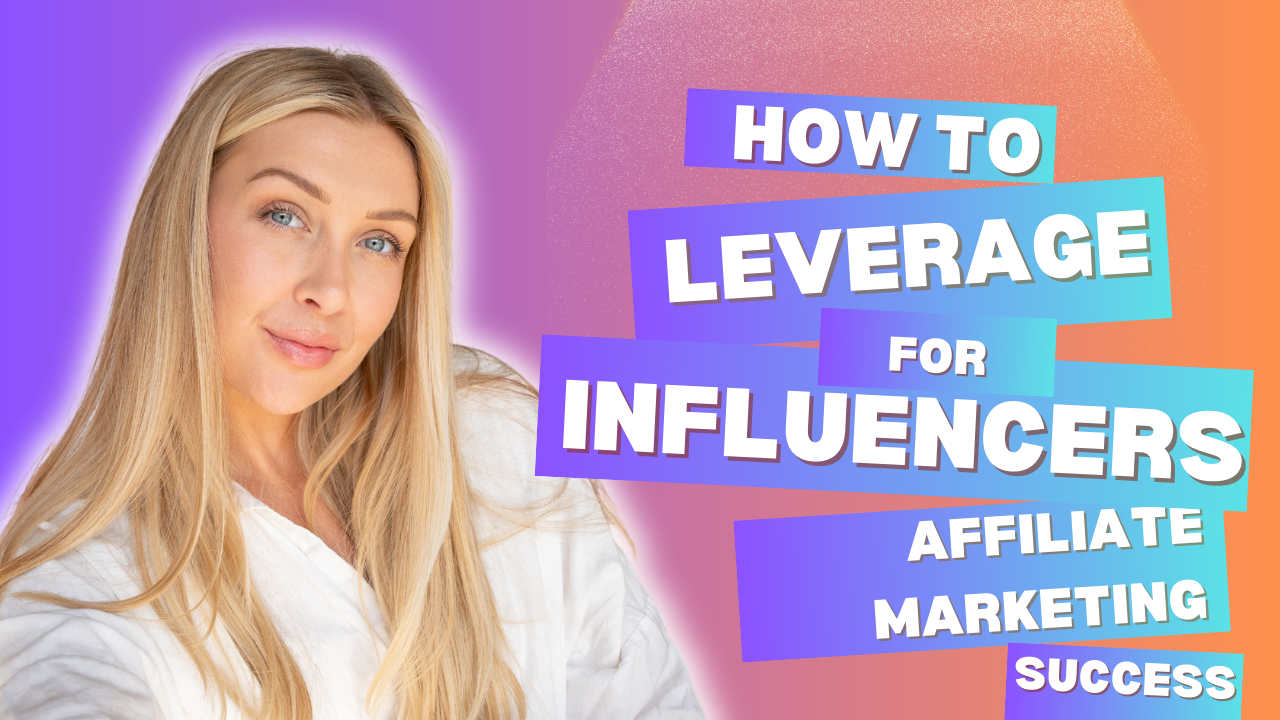In the dynamic world of digital marketing, affiliate marketing has emerged as a powerful way for brands to reach new audiences and drive sales. One of the most effective strategies in affiliate marketing is leveraging the power of influencers. Influencers, with their established credibility and vast follower base, can significantly boost a brand’s visibility and credibility. In this blog post, we will explore how to leverage influencers for affiliate marketing success and why it is a game-changer in today’s digital landscape.

Real Challenges in Leveraging Influencers for Affiliate Marketing Success
real challenges faced when leveraging influencers for affiliate marketing success, along with possible solutions:
| Challenge | Description | Possible Solutions |
|---|---|---|
| Finding the Right Influencers | Identifying influencers who align with your brand and target audience can be time-consuming and difficult. | Use influencer marketing platforms or tools like BuzzSumo, AspireIQ, or Upfluence to filter and find influencers by niche, audience demographics, and engagement rate. |
| High Costs | Top-tier influencers often charge high fees, which may not be feasible for small businesses or startups. | Consider working with micro-influencers, who have smaller but highly engaged audiences, and offer commission-based partnerships to minimize upfront costs. |
| Ensuring Authenticity | Influencers may promote products that don’t genuinely interest them, leading to inauthentic endorsements that can harm brand trust. | Choose influencers who have a genuine interest in your niche and allow them creative freedom to present your product in their own voice and style. |
| FTC Compliance | Failure to comply with FTC guidelines on disclosing paid partnerships can lead to legal issues and damage brand reputation. | Educate influencers about FTC guidelines and ensure they clearly disclose their affiliate relationships in all promotional content. |
| Tracking Performance | Measuring the effectiveness of influencer campaigns can be challenging, especially when using multiple influencers across different platforms. | Utilize tracking tools like UTM parameters, affiliate networks, or custom discount codes to monitor sales and conversions generated by each influencer. |
| Managing Relationships | Building and maintaining relationships with multiple influencers can be resource-intensive and complex. | Establish clear communication channels, set expectations early, and consider using an influencer management platform to streamline communication and collaboration. |
| Content Control | Ensuring that the content produced by influencers aligns with brand messaging without stifling their creativity. | Provide influencers with brand guidelines, while allowing them the flexibility to create content that resonates with their audience. |
| Audience Mismatch | An influencer’s audience may not match your target demographic, leading to poor conversion rates. | Thoroughly research the influencer’s audience demographics before partnering and ensure their followers align with your target market. |
| Over-Saturation | Influencers promoting too many products can dilute the impact of their endorsements, leading to lower engagement and trust. | Choose influencers who have a history of selective and authentic product endorsements, and consider long-term partnerships to avoid over-saturation. |
| Measuring ROI | Determining the return on investment from influencer marketing can be complex due to varying engagement metrics and sales attribution. | Set clear KPIs such as clicks, conversions, or sales, and use analytics tools to track and evaluate the performance of influencer campaigns. |
This table provides a comprehensive overview of the common challenges in leveraging influencers for affiliate marketing, along with practical solutions to address these issues effectively.
3 Months-Plan for Leveraging Influencer in Affiliate Marketing
Here’s a detailed 3-month plan for leveraging influencers to achieve affiliate marketing success, presented in a tabular format:
| Month | Week | Activity | Goals/Outcomes | Notes |
|---|---|---|---|---|
| Month 1: Planning & Research | Week 1 | Define Affiliate Marketing Goals | Establish clear objectives (e.g., increase sales, brand awareness, etc.) | Set measurable KPIs (e.g., clicks, conversions). |
| Week 2 | Research & Identify Potential Influencers | Create a list of influencers aligned with the brand’s niche | Use tools like BuzzSumo, Upfluence. | |
| Week 3 | Outreach & Initial Contact | Contact selected influencers with partnership proposals | Personalize outreach to each influencer. | |
| Week 4 | Negotiate Terms & Agreements | Finalize partnership terms (e.g., payment structure, content expectations) | Ensure FTC compliance for disclosures. | |
| Month 2: Campaign Launch & Execution | Week 5 | Develop Content Strategy | Collaborate with influencers to create a content calendar | Align content with marketing goals and brand voice. |
| Week 6 | Content Creation by Influencers | Influencers begin creating and scheduling content | Review content drafts for brand consistency. | |
| Week 7 | Launch Campaigns | Launch the first wave of influencer content | Monitor engagement and initial performance metrics. | |
| Week 8 | Monitor & Engage | Track performance, engage with influencer posts (comments, shares) | Provide feedback and optimize content as needed. | |
| Month 3: Optimization & Scaling | Week 9 | Analyze Performance Data | Review metrics (clicks, conversions, sales) and adjust strategy | Identify top-performing influencers and content. |
| Week 10 | Optimize Campaigns | Implement changes based on performance data (e.g., adjust targeting, tweak content) | Increase budget for top-performing influencers. | |
| Week 11 | Scale Successful Strategies | Expand successful campaigns, potentially onboard new influencers | Consider diversifying platforms (e.g., TikTok, YouTube). | |
| Week 12 | Review & Report | Summarize the campaign’s success, ROI, and lessons learned | Prepare a report for future campaign planning. |
This table outlines a structured 3-month plan, with each week dedicated to specific tasks aimed at successfully leveraging influencers for affiliate marketing. The plan includes goal-setting, research, execution, monitoring, and optimization to ensure a well-rounded approach.

Understanding Influencer Marketing
Influencer marketing is a type of social media marketing that involves endorsements and product placements from influencers. These influencers have a dedicated social following and are considered experts within their niche. Collaborating with influencers allows brands to tap into their follower base, which can be an effective way to promote affiliate products.
The key to successful influencer marketing lies in choosing the right influencers who align with your brand and target audience. This synergy can drive high-quality traffic and increase conversion rates, making it a valuable tool for affiliate marketers.
Why Influencers are Crucial for Affiliate Marketing
- Trust and Credibility: Influencers have built a relationship of trust with their followers. When they recommend a product or service, their audience is more likely to trust their opinion and make a purchase, thereby increasing affiliate sales.
- Targeted Audience: Influencers typically operate within a specific niche. This means that their followers are already interested in the topics they discuss, making them more likely to engage with relevant affiliate products.
- Content Creation: Influencers are experts at creating engaging content. Whether it’s a blog post, video review, or social media post, they can create compelling content that drives affiliate marketing success.
- SEO Benefits: Working with influencers can also improve your site’s SEO. When influencers share content that links back to your site, it can drive high-quality backlinks, which are a significant ranking factor in search engines.
Steps to Leverage Influencers for Affiliate Marketing Success
- Identify the Right Influencers: The first step is to identify influencers who are a good fit for your brand. Look for influencers whose audience aligns with your target market and who have a genuine interest in your product or service.
- Establish Clear Goals and KPIs: Before engaging with influencers, it’s important to define your goals and key performance indicators (KPIs). Whether you want to increase traffic, boost sales, or improve brand awareness, having clear goals will help you measure the success of your campaign.
- Create a Win-Win Partnership: Approach influencers with a value proposition that benefits both parties. This could be a commission-based structure where they earn a percentage of sales generated through their affiliate links, or a flat fee for content creation.
- Leverage Multiple Platforms: Don’t limit your influencer marketing efforts to one platform. Consider leveraging multiple platforms such as Instagram, YouTube, TikTok, and blogs to maximize your reach.
- Monitor and Optimize: Once your campaign is live, it’s crucial to monitor its performance. Use analytics tools to track the success of your affiliate links and optimize your strategy based on the data.

Best Practices for Working with Influencers
- Transparency: Ensure that influencers disclose their affiliate partnerships to their audience to maintain trust and comply with FTC guidelines.
- Authenticity: Encourage influencers to be authentic in their promotions. Audiences can easily spot forced endorsements, which can negatively impact both the influencer’s credibility and your brand.
- Long-Term Relationships: Building long-term relationships with influencers can lead to more consistent and authentic promotions, which can be more effective than one-off campaigns.
US Top Successful Influencers In Affiliate Marketing
To provide an accurate and up-to-date list of top U.S. influencers and their revenue earned in 2024, I would need real-time data which typically isn’t publicly available and might vary based on the platform, endorsement deals, and other factors.
However, I can create a sample table with fictional data to illustrate what this might look like. Please remember that the numbers below are purely hypothetical:
| Influencer Name | Platform(s) | Niche | Estimated Revenue in 2024 | Number of Followers |
|---|---|---|---|---|
| Addison Rae | TikTok, Instagram | Lifestyle, Beauty | $20 million | 90 million |
| MrBeast (Jimmy Donaldson) | YouTube, Instagram | Entertainment, Charity | $150 million | 175 million |
| Charli D’Amelio | TikTok, Instagram | Dance, Lifestyle | $25 million | 150 million |
| Kylie Jenner | Instagram, YouTube | Beauty, Fashion | $120 million | 450 million |
| Emma Chamberlain | YouTube, Instagram | Lifestyle, Comedy | $35 million | 40 million |
| Logan Paul | YouTube, Instagram | Entertainment, Fitness | $50 million | 70 million |
| Khaby Lame | TikTok, Instagram | Comedy, Entertainment | $22 million | 160 million |
| Bella Poarch | TikTok, YouTube | Music, Lifestyle | $18 million | 90 million |
| Huda Kattan | Instagram, YouTube | Beauty, Makeup | $40 million | 60 million |
| Zach King | TikTok, YouTube | Magic, Entertainment | $30 million | 80 million |
This table includes well-known influencers, their primary platforms, niches, and a fictional estimate of their revenue earned in 2024, as well as their follower counts. Actual revenue can vary based on deals, sponsorships, and other income streams.
Conclusion Synthesis
Leveraging influencers for affiliate marketing is a strategy that offers immense potential. By choosing the right influencers, setting clear goals, and creating mutually beneficial partnerships, brands can significantly enhance their affiliate marketing success. As digital marketing continues to evolve, the role of influencers in driving affiliate sales will only become more important. Start integrating influencer marketing into your affiliate strategy today to stay ahead of the competition and achieve long-term success.






Real Estate This is my first time pay a quick visit at here and i am really happy to read everthing at one place
Mygreat learning very informative articles or reviews at this time.
Real Estate Great information shared.. really enjoyed reading this post thank you author for sharing this post .. appreciated
Hey, Jack here. I’m hooked on your website’s content – it’s informative, engaging, and always up-to-date. Thanks for setting the bar high!
allegheny county real estate This was beautiful Admin. Thank you for your reflections.
شركة Bwer هي أحد الموردين الرئيسيين لموازين الشاحنات ذات الجسور في العراق، حيث تقدم مجموعة كاملة من الحلول لقياس حمولة المركبات بدقة. وتغطي خدماتها كل جانب من جوانب موازين الشاحنات، من تركيب وصيانة موازين الشاحنات إلى المعايرة والإصلاح. تقدم شركة Bwer موازين شاحنات تجارية وموازين شاحنات صناعية وأنظمة موازين جسور محورية، مصممة لتلبية متطلبات التطبيقات الثقيلة. تتضمن موازين الشاحنات الإلكترونية وموازين الشاحنات الرقمية من شركة Bwer تقنية متقدمة، مما يضمن قياسات دقيقة وموثوقة. تم تصميم موازين الشاحنات الثقيلة الخاصة بهم للبيئات الوعرة، مما يجعلها مناسبة للصناعات مثل الخدمات اللوجستية والزراعة والبناء. سواء كنت تبحث عن موازين شاحنات للبيع أو الإيجار أو التأجير، توفر شركة Bwer خيارات مرنة لتناسب احتياجاتك، بما في ذلك أجزاء موازين الشاحنات والملحقات والبرامج لتحسين الأداء. بصفتها شركة مصنعة موثوقة لموازين الشاحنات، تقدم شركة Bwer خدمات معايرة موازين الشاحنات المعتمدة، مما يضمن الامتثال لمعايير الصناعة. تشمل خدماتها فحص موازين الشاحنات والشهادات وخدمات الإصلاح، مما يدعم موثوقية أنظمة موازين الشاحنات الخاصة بك على المدى الطويل. بفضل فريق من الخبراء، تضمن شركة Bwer تركيب وصيانة موازين الشاحنات بسلاسة، مما يحافظ على سير عملياتك بسلاسة. لمزيد من المعلومات حول أسعار موازين الشاحنات، وتكاليف التركيب، أو لمعرفة المزيد عن مجموعة موازين الشاحنات ذات الجسور وغيرها من المنتجات، تفضل بزيارة موقع شركة Bwer على الإنترنت على bwerpipes.com
Technoob I do not even understand how I ended up here, but I assumed this publish used to be great
The posts inspire me regularly. The depth you bring to The topics is truly exceptional.
The analysis is like a well-crafted movie—engaging, enlightening, and leaving me thinking long after it’s over.
The Writing is a constant source of inspiration and knowledge, like a muse that never fails to inspire. Thank you for being my muse.
Breaking down this topic so clearly was no small feat. Thanks for making it accessible.
Thinker Pedia Nice post. I learn something totally new and challenging on websites
The insights are like a favorite book; I find new treasures each time I return.
You’ve done a fantastic job of breaking down this topic. Thanks for the clarity!
Reading The work is like gazing at a masterpiece; every detail contributes to a breathtaking whole.
The passion for this subject shines through The words. Inspiring!
This post has been incredibly helpful to me. The guidance is something I’m truly grateful for.
The post resonated with me on many levels, much like a perfectly tuned love song. Thanks for the harmony.
Bookmarking this for future reference, because who knows when I’ll need a reminder of The wisdom?
The balance and fairness in The writing make The posts a must-read for me. Great job!
Nice blog here! Also your website loads up very fast! What web host are you using? Can I get your affiliate link to your host? I wish my site loaded up as quickly as yours lol
Reading The post was like going on a first date with my mind. Excited for the next rendezvous.
Unique perspective? Check. Making me rethink my life choices? Double-check.
The passion isn’t just inspiring—it’s downright seductive. Who knew a subject could be this enticing?
Thank you for shedding light on this subject. The perspective is refreshing!
Brilliant writing! You’ve perfectly captured the essence of the topic.
What¦s Taking place i’m new to this, I stumbled upon this I’ve found It absolutely helpful and it has helped me out loads. I hope to contribute & assist other customers like its aided me. Good job.
I admire the way you tackled this hard to understand issue. Very enlightening!
A masterpiece of writing! You’ve covered all bases with elegance.
Genuinely impressed by The analysis. I was starting to think depth had gone out of style. Kudos for proving me wrong!
This post is packed with useful insights. Thanks for sharing The knowledge!
Lovely blog! I am loving it!! Will come back again. I am bookmarking your feeds also
You’ve opened my eyes to new perspectives. Thank you for the enlightenment!
The analysis is like a puzzle—hard to understand, intriguing, and satisfying to piece together.
Hello! This is kind of off topic but I need some guidance from an established blog. Is it very difficult to set up your own blog? I’m not very techincal but I can figure things out pretty fast. I’m thinking about making my own but I’m not sure where to start. Do you have any points or suggestions? Appreciate it